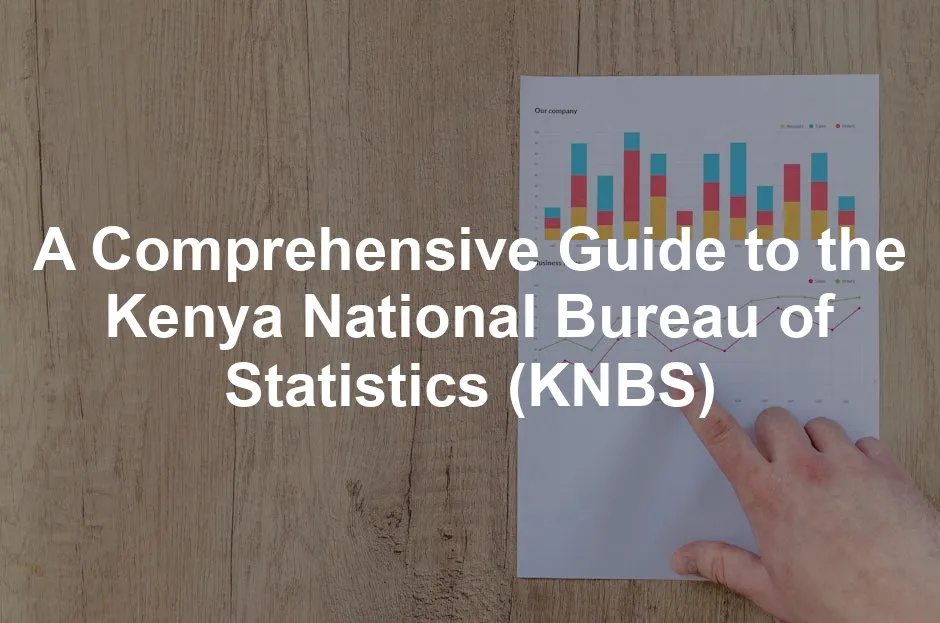Introduction
The Kenya National Bureau of Statistics (KNBS) is the heart of data collection in Kenya. Established in 2006, it serves as the principal agency for gathering and disseminating statistical information. Picture it as the librarian of Kenya’s vast data library, tirelessly cataloging facts and figures that illuminate the country’s socio-economic landscape. The significance of KNBS cannot be overstated; it underpins informed decision-making across various sectors, from government policy to business planning.
Statistics play a vital role in shaping the future of any nation. They are not just numbers; they are the backbone of policy-making. When the government crafts policies, it relies on solid data from KNBS to guide its decisions. Whether it’s economic planning or addressing societal issues, accurate statistics are essential. They help identify trends, allocate resources, and evaluate the impact of governmental programs. In short, without robust statistics, policymakers would be like sailors navigating without a compass—lost at sea!
This article aims to provide a thorough understanding of KNBS, its history, mission, and vision. We’ll explore its key functions, highlight recent statistics, and showcase the latest publications. We want to ensure that you leave with a crystal-clear picture of how KNBS operates and why it matters to every Kenyan citizen.

Understanding the Kenya National Bureau of Statistics (KNBS)
History and Establishment
The journey of KNBS began with the Statistics Act of 2006. This landmark legislation established the Bureau, transitioning from various earlier statistical bodies that operated in a fragmented manner. Before KNBS, statistical functions in Kenya were scattered across several ministries, leading to inconsistencies and gaps in data collection. The formation of KNBS marked a significant shift toward a centralized approach, aiming for better coordination and more reliable data.
The Bureau officially commenced operations in February 2007. Since then, it has embraced a mission to provide high-quality statistical information that informs policy and decision-making. This transformation was crucial for Kenya, laying the groundwork for a more data-driven approach to governance and planning.
Mission and Vision
At the core of KNBS lies a mission committed to the highest standards of data quality and service delivery. The Bureau aims to produce reliable statistics that are accessible to all stakeholders. This commitment ensures that data is not just collected but is also effectively disseminated to those who need it.
KNBS envisions a future where data-driven decision-making is the norm across all sectors. The strategic goals outlined by the Bureau include enhancing data collection methodologies and improving stakeholder engagement. By prioritizing these aspects, KNBS seeks to foster a culture of transparency and accountability in governance. The Bureau recognizes that when citizens have access to accurate data, they can hold their leaders accountable and participate meaningfully in national development.
In conclusion, KNBS is more than just a statistical agency; it is a catalyst for change. Its commitment to quality data contributes significantly to the sustainable development of Kenya.

Key Functions of KNBS
The Kenya National Bureau of Statistics (KNBS) serves as the national custodian of statistical data in Kenya. Its key functions revolve around data collection, analysis, and dissemination. Let’s break down these essential roles.
Data Collection and Management
Data collection at KNBS is a meticulous process. It primarily involves conducting surveys and censuses. A census is like a grand family reunion, but instead of relatives, it gathers every single person in the country. The Kenya Population and Housing Census occurs every ten years, providing a snapshot of the nation’s demographics. The last one was in 2019, revealing crucial insights about population growth and distribution.
Surveys are more frequent, covering various sectors like agriculture and education. For instance, the National Sampling Survey and Evaluation Programme focuses on household data, ensuring that no household is left behind. Accuracy is paramount here. Imagine if a survey mistakenly reported that there were 10 million fewer people in Kenya. That would be like saying there’s only one slice of cake left at a party when, in fact, the cake is still whole!
Reliability is equally important. KNBS uses rigorous methods to ensure that data reflects the reality on the ground. This means employing trained enumerators and utilizing technology for data collection. The aim? To produce statistics that policymakers and researchers can trust.
If you’re interested in diving deeper into data collection methods, check out this Data Collection Tools for Surveying. These tools can help streamline your data gathering efforts and ensure accuracy in your findings.

Analysis and Dissemination
Once data is collected, the real fun begins—analysis! KNBS employs statistical techniques to interpret the data, transforming raw numbers into meaningful insights. This analysis helps identify trends and patterns, like spotting a rise in youth unemployment or changes in consumer behavior.
But what’s the point of collecting and analyzing if no one sees the results? Dissemination is where KNBS shines. The Bureau publishes reports in various formats, including PDFs, Excel sheets, and interactive dashboards. This ensures that stakeholders—from government officials to curious citizens—can access the information they need.
Moreover, KNBS understands the importance of timely data. In a world that moves at lightning speed, having current information can make a significant difference. Regular updates on economic indicators, like GDP growth and inflation rates, are made available, helping everyone stay informed.
For those looking to master data analysis techniques, consider picking up a copy of Statistical Methods for Research. This book is perfect for researchers looking to enhance their analytical skills.
Understanding effective data analysis is crucial for interpreting the findings from KNBS. Learn more about effective data analysis techniques.

Major Programs and Initiatives
Kenya Population and Housing Census
The Kenya Population and Housing Census is perhaps the most notable initiative of KNBS. Conducted every ten years, it’s a crucial tool for planning and development. The latest census, carried out in 2019, revealed that Kenya’s population had surged to over 47 million. Among the notable findings was a gender distribution that showed slightly more females than males—24 million women compared to 23.5 million men. This data is invaluable for resource allocation, social services planning, and understanding demographic changes.
To gain a deeper understanding of the census data, you might want to check out the Kenya Population and Housing Census 2019 Report. This comprehensive report provides detailed insights into demographic changes across the nation.

National Sampling Survey and Evaluation Programme
Another key initiative is the National Sampling Survey and Evaluation Programme. This program focuses on collecting household data to provide insights into living conditions and socio-economic status. The impact of this program is profound; it helps policymakers craft targeted interventions for poverty alleviation and socio-economic development. By understanding household dynamics, KNBS aids in shaping policies that directly affect people’s lives.
In summary, the functions of KNBS are vital for the development of Kenya. Through systematic data collection, insightful analysis, and effective dissemination, KNBS ensures that the country’s statistical needs are met, paving the way for informed decision-making and sustainable growth.

Latest Statistics and Reports
Current Population Statistics
As of mid-2024, Kenya’s population stands at a remarkable 52,428,290. This figure showcases not just a number, but a vibrant tapestry of diverse cultures and communities. Now, let’s break it down a bit further.
When we look at gender distribution, the scales tip slightly in favor of females. According to the latest census data, there are approximately 24 million women and 23.5 million men. That’s a gender ratio that keeps the social dynamics interesting!
Population density is another intriguing aspect. Kenya’s density is about 82 people per square kilometer, which can feel quite cozy, especially in urban areas. This density plays a crucial role in resource allocation and urban planning, impacting everything from housing to transportation.

Economic Indicators
The economic landscape of Kenya is as dynamic as its geography. Recent reports detail several key indicators that reveal the state of the economy. First up, GDP growth for Q1 2024 is reported at a healthy 5.0%. This growth reflects a robust recovery from previous economic challenges, spurred by various sectors bouncing back with enthusiasm.
Inflation rates are under control, with the Consumer Price Index (CPI) at 3.6% as of September 2024. This figure suggests that the cost of living is relatively stable, making it easier for families to plan their budgets without too many surprises.
However, poverty remains a pressing issue. The poverty rate currently sits at 38.6%, based on the 2021 headcount. This statistic reminds us that while the economy grows, concerted efforts are needed to lift many Kenyans out of poverty.
For a comprehensive understanding of Kenya’s economic landscape, the Kenya Economic Survey 2024 is a must-read. It provides detailed insights into economic performance and forecasts, crucial for anyone looking to stay informed on the country’s financial health.

Sector-Specific Insights
Agriculture
Agriculture, the backbone of Kenya’s economy, continues to be a vital sector. Recent statistics show that agricultural output remains significant. For instance, tea production has slightly dipped, falling from 58,966.9 metric tons in January 2024 to 55,447.3 metric tons in February. Despite this decline, Kenya remains a major player in the global tea market.
In terms of exports, coffee has recently shown promise. Coffee exports jumped from 2,745.2 metric tons in February to 4,291.3 metric tons in March 2024. This upward trend is encouraging for farmers and the economy alike, showcasing the resilience of Kenyan agriculture.
If you’re keen on understanding coffee cultivation, grab a copy of Coffee Growing in Kenya: A Comprehensive Guide. This book provides invaluable insights for both novice and experienced coffee farmers.

Trade and Finance
Moving to trade, the statistics paint a picture of fluctuating volumes. Trade value dropped from KSh 333.8 billion in February 2024 to KSh 306.2 billion in March 2024. Exports also saw a decline, going from KSh 107.4 billion to KSh 97.9 billion in the same period. This contraction underlines the need for strategic efforts to boost trade, particularly in the face of global economic shifts.
On the finance front, national government revenue is projected to rise by 14.9%, reaching KSh 2,562.1 billion in 2022/23. This increase is primarily driven by improved tax collection, which accounts for a staggering 87.9% of total revenue. Such growth can provide much-needed resources for public services and infrastructure development.

Tourism
Lastly, let’s not forget tourism—a sector that brings both joy and significant revenue. The number of international visitors soared by 35.4%, from 1,541.0 thousand in 2022 to 2,086.8 thousand in 2023. This rebound speaks volumes about Kenya’s allure as a travel destination.
National parks have also seen a surge in attendance, with visitor numbers increasing by 43% to reach 3,637.3 thousand in 2023. This uptick not only supports conservation efforts but also boosts local economies reliant on tourism.
If you’re planning a visit, don’t forget to check out the Kenya National Parks Guidebook. This guide will help you navigate the stunning landscapes and wildlife of Kenya’s national parks.
In summary, the latest statistics from the Kenya National Bureau of Statistics reveal a country on the move. While challenges remain, particularly regarding poverty and trade fluctuations, the overall picture is one of resilience and growth. Data plays a pivotal role in shaping policies and strategies that can further bolster Kenya’s economy, ensuring that progress continues for all citizens.

Recent Publications and Statistical Releases
Overview of Publications
The Kenya National Bureau of Statistics (KNBS) publishes a range of reports crucial for understanding the country’s socio-economic landscape. Among the key publications are the Statistical Abstract and the Economic Survey.
The Statistical Abstract serves as an annual compilation of essential statistics, offering a snapshot of various sectors like population, health, and economy. It’s the go-to guide for researchers, policymakers, and anyone curious about Kenya’s statistics.
Then there’s the Economic Survey, which highlights economic performance over a year. This publication is vital for businesses, government agencies, and international investors. It provides insights into GDP growth, inflation rates, and sector-specific performance, helping stakeholders make informed decisions.
These publications aren’t just numbers on a page; they’re tools for various stakeholders. Policymakers rely on them to craft strategies. Businesses use insights to plan investments. Researchers draw data for studies. Even the average citizen can gain a better understanding of national trends. The value of these publications extends far beyond their pages.

Accessing KNBS Data
Accessing KNBS reports is straightforward. Head over to the KNBS website where a treasure trove of data awaits. Most reports are available for download in PDF format, making it easy for anyone to access critical statistics.
Recent notable publications include the 2024 Economic Survey and the 2023 Statistical Abstract. The Economic Survey provides a detailed analysis of economic trends for 2024, highlighting a GDP growth of 5.0% for Q1. Meanwhile, the Statistical Abstract offers a comprehensive view of demographics, poverty rates, and more, essential for anyone analyzing the country’s development.
For those involved in research or planning, keeping an eye on these releases can be a game-changer. The data informs everything from economic policies to social programs, ensuring decisions are backed by accurate information.

Opportunities and Events at KNBS
Career and Internship Opportunities
The KNBS is not just about data; it’s also about people. There are various employment and internship opportunities available. Joining the team means contributing to national statistical efforts that shape policies and improve lives.
Internships at KNBS provide hands-on experience in data collection and analysis, perfect for students and recent graduates looking to make a mark in the statistical field. It’s a chance to learn from the best while playing a part in Kenya’s development.
Working at KNBS is more than just a job; it’s a commitment to enhancing the country’s data landscape. Every statistic collected is a step toward better governance and improved quality of life for all Kenyans.

Recent Events and Workshops
KNBS frequently organizes events, including workshops and training sessions aimed at bolstering data literacy. For instance, a recent workshop focused on data interoperability, emphasizing the integration of administrative and survey data. Such events are critical for building capacity among stakeholders.
These gatherings foster collaboration, encouraging participants to engage with the latest statistical techniques and technologies. By enhancing skills and knowledge, KNBS is empowering a new generation of data enthusiasts.
Moreover, events like the Nairobi International Trade Fair allow KNBS to showcase its work. Here, they present valuable statistical insights, making information accessible to the public. Whether you’re a student, a researcher, or just a curious citizen, these events offer a wealth of information and networking opportunities.
In essence, KNBS isn’t just about collecting data; it’s about sharing knowledge and building a community around statistics. By participating in these opportunities, individuals contribute to a stronger foundation for data-driven decision-making in Kenya.

Challenges and Future Outlook
Challenges Faced by KNBS
The Kenya National Bureau of Statistics (KNBS) plays a pivotal role in providing data for shaping policies and driving socio-economic progress. However, it faces several challenges that hinder its effectiveness.
First up, budget constraints. In a world where every penny counts, KNBS often finds itself juggling its budget like a circus performer. Limited funds can lead to reduced capacity to conduct comprehensive surveys and maintain data quality. Imagine trying to bake a cake with only half the ingredients—results might be less than appetizing!
Public trust is another hurdle. Statistics can sometimes feel like a mystery wrapped in an enigma. When data collection methods are questioned, it can erode public confidence in the statistics provided. If citizens don’t trust the data, they might dismiss the findings, which could lead to misguided policies.
Technological advancements also present a double-edged sword. While new technologies offer exciting opportunities for data collection and analysis, they can also pose challenges. Not all regions in Kenya are tech-savvy, and disparities in access can lead to gaps in data. Furthermore, as tech evolves, so must the training of personnel who are often required to keep pace with rapid changes.
These challenges highlight the importance of continuous improvement and adaptation within KNBS. Addressing these issues is crucial for the Bureau to deliver reliable statistics that contribute to informed decision-making.

Future Directions
Looking ahead, KNBS has set ambitious strategic plans to enhance data collection and analysis. One of the focal points is embracing technological innovations. By investing in new data collection tools and methodologies, KNBS aims to streamline processes and improve data accuracy. This might involve mobile data collection apps that allow enumerators to gather information in real-time, reducing errors and improving efficiency.
Moreover, the Bureau plans to enhance stakeholder engagement. Collaborating with various sectors—government, private, and civil society—can lead to more comprehensive data that reflects the diverse realities of Kenyans. By fostering these partnerships, KNBS hopes to gather richer data that informs policies at all levels.
Additionally, there is an emphasis on capacity building. Training personnel to handle new technologies and methodologies will be vital. This approach ensures that the staff is well-equipped to meet the evolving demands of data collection and analysis.
In terms of policy changes, KNBS anticipates updates that promote open data initiatives. Making data more accessible to the public can enhance transparency and accountability. When citizens can access reliable statistics, they can hold leaders accountable and participate meaningfully in governance.
In conclusion, while KNBS faces challenges, its forward-thinking strategies aim to transform these hurdles into stepping stones for improved data collection and analysis. By prioritizing innovation, collaboration, and capacity building, KNBS is set to strengthen its role as a crucial player in Kenya’s socio-economic landscape.
Conclusion
In summary, the Kenya National Bureau of Statistics (KNBS) serves as the backbone of statistical data in Kenya. By providing reliable and comprehensive data, it plays a critical role in shaping the nation’s socio-economic policies.
From its establishment in 2006 to its current operations, KNBS has evolved significantly. Its mission focuses on ensuring that statistical information is accurate, accessible, and relevant. The key functions of data collection, analysis, and dissemination are vital for informed decision-making at all levels of governance.
Despite facing challenges, such as budget constraints and public trust issues, KNBS is actively working to enhance its operations. The strategic plans for the future include embracing technology, improving stakeholder engagement, and ensuring data accessibility. These efforts will fortify KNBS’s critical role in Kenya’s development journey.
Ultimately, the work of KNBS impacts every Kenyan citizen. The statistics provided not only guide policymakers but also empower individuals to make informed decisions. As Kenya continues to navigate its development path, the data from KNBS will remain a cornerstone in building a sustainable future.
FAQs
What is the role of the Kenya National Bureau of Statistics?
The Kenya National Bureau of Statistics (KNBS) is responsible for collecting, analyzing, and disseminating statistical data in Kenya. It supports informed decision-making by providing accurate and reliable information on various socio-economic indicators.
How often does KNBS conduct the population census?
KNBS conducts the population census every ten years. The last census took place in 2019, providing essential demographic data for planning and development.
Where can I access KNBS reports and data?
You can access KNBS reports and data on their official website at [KNBS](https://www.knbs.or.ke/). The site offers a range of publications available for download, including the Statistical Abstract and Economic Survey.
What are the major challenges faced by KNBS?
KNBS encounters challenges such as budget constraints, public trust issues regarding data quality, and the need to keep pace with technological advancements. Addressing these challenges is essential for the Bureau to fulfill its mission effectively.
Please let us know what you think about our content by leaving a comment down below!
Thank you for reading till here 🙂
All images from Pexels




